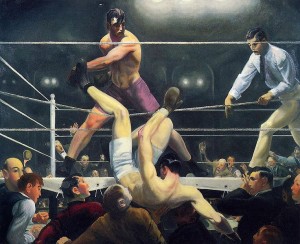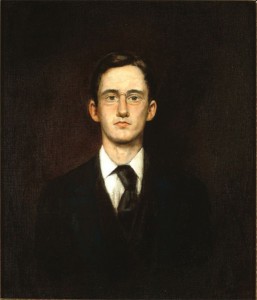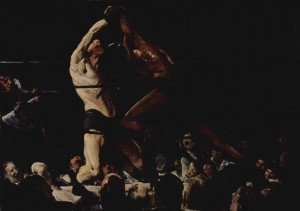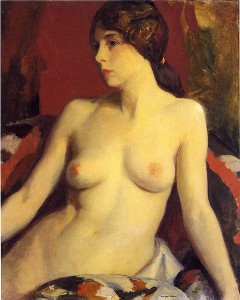Art Movements: American REALISM

George Bellows, Dempsey and Firpo (1924), Whitney Museum of American Art
American realism was a turn of the century idea in art, music and literature that showed through these different types of work, reflections of the time period. Whether it was a cultural portrayal, or a scenic view of downtown New York City, these images and works of literature, music and painting depicted a contemporary view of what was happening; an attempt at defining what was real. In America at the beginning of the 20th century a new generation of painters, writers and journalists were coming of age. Many of the painters felt the influence of older American artists like Thomas Eakins, Mary Cassatt, John Singer Sargent, James McNeill Whistler, Winslow Homer, Childe Hassam, J. Alden Weir, Thomas Pollock Anshutz, and William Merritt Chase. However they were interested in creating new and more urbane works that reflected city life and a population that was more urban than rural in America as it entered the new century.
Introduction
During the late 19th century, and into the 20th century artists and musicians contributed to the idea of realism in the American setting. Each, though slightly different in concept or subject, was defining what was going on in front of his or her eyes, without imagining a past or a future. While it has been stated that American Realism was a Neoclassical movement borrowing from ancient classical interpretations of art and architecture, this statement is false. American Realism was actually the opposite; instead of reflecting back to antiquities, artists, writers and musicians were concerned with recording the grit and the true realityof the early 20th century in America.
America at the turn of the century

Self-portrait, 1890, oil on window shade, 14 x 11 7/8 inches, Delaware Art Museum, Gift of Helen Farr Sloan, 1970. A young man teaching himself to oil paint from a book, Sloan painted on whatever was available—in this case a window shade—and from the only model available, himself.
From the late 19th to the early 20th centuries, the United States experienced enormous industrial, economic, social and cultural change. A continuous wave of European immigration and the rising potential for international trade brought increasing growth and prosperity to America. Through art and artistic expression (through all mediums including painting, literature and music),American Realism attempted to portray the exhaustion and cultural exuberance of the figurative American landscape and the life of ordinary Americans at home. Artists used the feelings, textures and sounds of the city to influence the color, texture and look of their creative projects. Musicians noticed the quick and fast paced nature of the early 20th century and responded with a fresh and new tempo. Writers and authors told a new story about Americans; boys and girls real Americans could have grown up with. Pulling away from fantasy and focusing on the now, American Realism presented a new gateway and a breakthrough — introducing modernism, and what it means to be in the present. The Ashcan School also known as The Eight and the group called Ten American Painters created the core of the new American Modernism in the visual arts.
Ashcan School
The Ashcan School was a group of New York City artists who sought to capture the feel of turn-of-the-century New York City, through realistic and unglamorized portraits of everyday life. These artists were not only depicting the rich and promising Fifth Avenue socialites, but the lower class richly and culturally textured immigrants. One critic of the time did not like their choice of subjects, which included alleys, tenements, slum dwellers, and in the case of John Sloan, taverns frequented by the working class. They became known as the revolutionary black gang and apostles of ugliness.

George Bellows, Both Members of This Club (1909), Oil on canvas, 45 1/4 x 63 1/8 in. (115 x 160.5 cm), National Gallery of Art
George Bellows
George Bellows (1882-1925), painted city life in New York City. His paintings had an expressionist boldness and a willingness to take risks. He had a fascination with violence as seen in his painting, Both Members of this Club, which depicts a rather gory boxing scene. In his painting titled Cliff Dwellers, (above), we find a city-scape that is not one particular view but a composite of many views.
Robert Henri

Mata Moana, 1920 by Robert Henri
Robert Henri, (1865-1921) was an important American Realist and a member of The Ashcan School. Henri was interested in the spectacle of common life. He focused on individuals, strangers, quickly passing in the streets in towns and cities. He had a sympathetic portrayal rather that a comic portrayal of people, often using a dark background to add to the warmth of the person portrayed. His works have a heavy impasto which stressed the materiality of the paint and the painter. He influenced Glackens, Luks, Shinn and Sloan. In 1906, he was elected to the National Academy of Design, but when painters in his circle were rejected for the Academy’s 1907 exhibition, he accused fellow jurors of bias and walked off the jury, resolving to organize a show of his own. He would later refer to the Academy as a cemetery of art.
Everett Shinn

Everett Shinn, Self-portrait, 1901
Everett Shinn (1876-1953), a member of the Ashcan School, he was the youngest member of the group of modernist painters who explored the depiction of real life. He is most famous for his numerous paintings of New York and the theater and of various aspects of luxury and modern life inspired by his home in New York City. He painted theater scenes from London, Paris and New York. He found interest in the urban spectacle of life, drawing parallels between the theater and crowded seats and life. Unlike an artist like Degas, Shinn depicted interaction between the audience and performer.
George Benjamin Luks

George B. Luks, Allen Street, c.1905,Hunter Museum of American Art;
Chattanooga, Tennessee.
George B. Luks (1866-1933), was an Ashcan school artist whom lived on the Lower East Side ofManhattan. In Luks’ painting, Hester Street (1905), he shows children being entertained by a man with a toy while a woman and shopkeeper have a conversation in the background. The viewer is among the crowd rather than above it. Luks puts a positive spin on the Lower East Side by showing two young girls dancing in The Spielers, which is a type of dance that working glass immigrants would engage in; despite the poverty, children dance on the street. He looks for the joy and beauty in the life of the poor rather than the tragedy.
William Glackens

William Glackens, Coney Island Fruit Stand, 1898
William Glackens (1870-1938), painted the neighborhood surrounding his studio in Washington Square Park. Instead of using strangers Glackens got his friends to pose in their finest clothes as café goers and shoppers. His work relates to Manet in that they both convey the glitter, fashion, spectacle and isolation of urban nightlife. In The Shoppers, Glackens depicts consumerism which was a rising activity for women in their lives as urban dwellers.
John Sloan

John Sloan (1871-1951), was an Early 20th Century Realist of the Ashcan School, whose concerns with American social conditions led him to join the Socialist Party in 1910. Originally fromPhiladelphia, he worked in New York after 1904. From 1912–1916, he contributed illustrations to the socialist monthly The Masses. Sloan disliked propaganda, and in his drawings for The Masses, as in his paintings, he focused on the everyday lives of people. He depicted the leisure of the working class with an emphasis on female subjects. Among his best known works are Picnic Grounds andSunday, Women Drying their Hair. He disliked the Ashcan School label, and expressed his annoyance with art historians who identified him as a painter of the American Scene: “Some of us used to paint little rather sensitive comments about the life around us. We didn’t know it was the American Scene. I don’t like the name … A symptom of nationalism, which has caused a great deal of trouble in this world.”
Ernest Lawson
Ernest Lawson (1873-1939) was a Canadian-American painter. Though Lawson mostly paintedlandscapes, he also did some realistic urban scenes which were shown at the 1908 exhibition of The Eight. His painting style is heavily influenced by Impressionism, especially the style of John Henry Twachtman, Alfred Sisley, and J. Alden Weir.
Though considered an Impressionist, Lawson’s work stylistically falls between Impressionism and realism. He became associated with Henri’s circle of insurgents and was included in the landmark 1908 independent exhibition of The Eight organized to protest the jury system of the National Academy of Design annuals, though he also became involved with the Academy and showed there throughout his life.
Maurice Prendergast

Maurice Brazil Prendergast (1858–1924) was an American post-Impressionist artist who worked in oil, watercolor, and monotype. He was a member of The Eight, but the delicacy of his compositions and the mosaic-like beauty of his designs were unique; and his work was more imagination oriented; and idealistic than the other more pragmatic painters in the group. Prendergast’s work was more genteel than his more abrasive colleagues. His friendship with Vuillard and Bonnard placed him firmly in the postimpressionist camp. He developed and continued to elaborate a highly personal style, with boldly contrasting, jewel-like colors, and flattened, patternlike forms rhythmically arranged on a canvas. Forms were radically simplified and presented in flat areas of bright, unmodulated color. His paintings have been aptly described as tapestry-like or resembling mosaics.
Prendergast typically painted people involved in leisurely activities. At the Armory Show in 1913, he displayed seven works that showed his stylistic maturity. Although he predominantly worked in watercolors, he began using oils in his later career. He also produced a large number of monotypes between 1891 and 1902.
Arthur B. Davies

Arthur B. Davies (1863–1928) was an avant-garde American artist. He was born in Utica, New York and studied at the Chicago Academy of Design from 1879 to 1882. He briefly attended the Art Institute of Chicago and then moved to New York City where he studied at the Art Students League. Arthur B. Davies was president of the Association of American Painters and Sculptors and with Walt Kuhn the secretary andWalter Pach, he was the principal organizer of the 1913 Armory Show. Davies is best known for his ethereal figure paintings. He worked as abillboard painter, engineering draftsman, and magazine illustrator.
Edward Hopper

Edward Hopper (1882–1967) was a prominent American realist painter and printmaker. Hopper is the most modern of the American realists, and the most contemporary. While most popularly known for his oil paintings, he was equally proficient as a watercolorist and printmaker in etching. In both his urban and rural scenes, his spare and finely calculated renderings reflected his personal vision of modern American life.
Hopper’s teacher, artist Robert Henri, encouraged his students to use their art to “make a stir in the world”. He also advised his students, It isn’t the subject that counts but what you feel about it and Forget about art and paint pictures of what interests you in life. In this manner, Henri influenced Hopper, as well as famous students George Bellows and Rockwell Kent, and motivated them to render realistic depictions of urban life. Some artists in Henri’s circle, including another teacher of Hopper’s, John Sloan, became members of “The Eight”, also known as the Ashcan School of American Art. His first existing oil painting to hint at his famous interiors was Solitary Figure in a Theater (c.1904). During his student years, Hopper also painted dozens of nudes, still lifes, landscapes, and portraits, including his self-portraits.


This Post Has 0 Comments